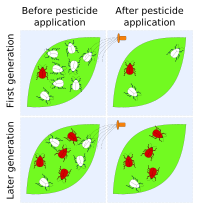
Photo from wikipedia
The genome resequencing of spontaneous glyphosate-resistant mutants derived from the soybean inoculant E109 allowed identifying genes most likely associated with the uptake (gltL and cya) and metabolism (zigA and betA)… Click to show full abstract
The genome resequencing of spontaneous glyphosate-resistant mutants derived from the soybean inoculant E109 allowed identifying genes most likely associated with the uptake (gltL and cya) and metabolism (zigA and betA) of glyphosate, as well as with nitrogen fixation (nifH). Mutations in these genes reduce the lag phase and improve nodulation under glyphosate stress. In addition to providing glyphosate resistance, the amino acid exchange Ser90Ala in NifH increased the citrate synthase activity, growth rate and plant growth-promoting efficiency of E109 in the absence of glyphosate stress, suggesting roles for this site during both the free-living and symbiotic growth stages.
Journal Title: Research in microbiology
Year Published: 2022
Link to full text (if available)
Share on Social Media: Sign Up to like & get
recommendations!